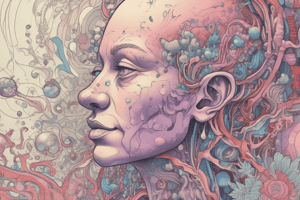Podcast
Questions and Answers
What do pale, white, muddy mucus membranes indicate
What do pale, white, muddy mucus membranes indicate
- Poor perfusion (correct)
- Excitement, fever
- Anemia (correct)
- Sepsis
What do hyper red mucous membranes indicate
What do hyper red mucous membranes indicate
- Poor perfusion
- Excitement, fever (correct)
- Anemia
- Sepsis (correct)
What do cherry red mucous membranes indicate
What do cherry red mucous membranes indicate
- Acetaminophen poisoning
- Carbon monoxide poisoning (correct)
- Fever, sepsis
- Hypoxemia
Monitoring device used to detect and amplify heart sounds via catheter
Monitoring device used to detect and amplify heart sounds via catheter
External monitor that measures the oxygen saturation level in the blood, also indicates HR
External monitor that measures the oxygen saturation level in the blood, also indicates HR
Device that monitors only the systolic blood pressure; hears blood flow
Device that monitors only the systolic blood pressure; hears blood flow
Monitors systolic and diastolic arterial pressure, and mean arterial pressure
Monitors systolic and diastolic arterial pressure, and mean arterial pressure
What does the end tidal CO2 do
What does the end tidal CO2 do
The 4 major body systems that need to be monitored
The 4 major body systems that need to be monitored
Parameters used to monitor the cardiovascular system
Parameters used to monitor the cardiovascular system
What is the normal color for mucous membranes
What is the normal color for mucous membranes
Cyanotic mucus membranes indicate
Cyanotic mucus membranes indicate
Icteric mucous membranes indicate
Icteric mucous membranes indicate
Brown mucous membranes in a cat may indicate
Brown mucous membranes in a cat may indicate
__________ lengthens CRT, while ___________ shortens CRT
__________ lengthens CRT, while ___________ shortens CRT
Shortened CRT can be caused by
Shortened CRT can be caused by
Lengthened CRT can be caused by
Lengthened CRT can be caused by
Where can you evaluate pulse
Where can you evaluate pulse
Inability to palpate pulse may indicate
Inability to palpate pulse may indicate
The dorsal pedal artery is best for what type of patients
The dorsal pedal artery is best for what type of patients
A pulse that lacks fullness is termed
A pulse that lacks fullness is termed
A pulse that is abnormally strong is termed
A pulse that is abnormally strong is termed
An abnormal or lack or pulse may indicate
An abnormal or lack or pulse may indicate
Normal heart rate for dogs
Normal heart rate for dogs
Normal heart rate in cats
Normal heart rate in cats
Volume of blood pumped by the heart each minute
Volume of blood pumped by the heart each minute
Volume of blood ejected per heartbeat
Volume of blood ejected per heartbeat
Compensatory mechanism to increase cardiac output even though stroke volume is decreased
Compensatory mechanism to increase cardiac output even though stroke volume is decreased
Causes of tachycardia
Causes of tachycardia
Causes of decreased respiratory rate
Causes of decreased respiratory rate
Increased respiratory rate is caused by
Increased respiratory rate is caused by
Clinical signs of respiratory problems
Clinical signs of respiratory problems
Which of the following diseases should be monitored closely
Which of the following diseases should be monitored closely
Less than 95 oxygen saturation is
Less than 95 oxygen saturation is
Visualizes the rhythm of the heart
Visualizes the rhythm of the heart
This ability is the hallmark of a good vet nurse
This ability is the hallmark of a good vet nurse
Termed used to describe oxygenation to the tissues
Termed used to describe oxygenation to the tissues
Which of the following is pulse quality that is associated with significant tachycardia
Which of the following is pulse quality that is associated with significant tachycardia
Decreased volume of circulating blood in the body
Decreased volume of circulating blood in the body
Dehydration can cause
Dehydration can cause
Heard when inflammation or bronchitis is present
Heard when inflammation or bronchitis is present
Cause of crackles
Cause of crackles
Cause of dry crackles
Cause of dry crackles
Rapid shallow breathing comes from
Rapid shallow breathing comes from
Labored pattern on expiration and respiration comes from
Labored pattern on expiration and respiration comes from
Muffled lung sounds come from
Muffled lung sounds come from
Flashcards are hidden until you start studying
Study Notes
Mucous Membranes
- Pale, white, muddy mucous membranes may indicate poor perfusion or shock.
- Hyper red mucous membranes suggest hyperemia or systemic infection.
- Cherry red mucous membranes can indicate carbon monoxide poisoning or methemoglobinemia.
- Cyanotic mucous membranes indicate inadequate oxygenation (hypoxia).
- Icteric mucous membranes suggest liver disease or hemolytic anemia.
- Brown mucous membranes in a cat might indicate methemoglobinemia.
Monitoring Devices
- A catheter-based monitoring device detects and amplifies heart sounds.
- An external monitor measures blood oxygen saturation levels and heart rate.
- A device that measures only systolic blood pressure detects flow sounds.
- Equipment that monitors systolic, diastolic arterial pressure, and mean arterial pressure is crucial for hemodynamic assessment.
- End tidal CO2 indicates the adequacy of ventilation and CO2 elimination.
Body Systems and Parameters
- The four major body systems to monitor include cardiovascular, respiratory, neurological, and renal systems.
- Cardiovascular system parameters include heart rate, rhythm, blood pressure, and perfusion.
Clinical Monitoring Metrics
- Normal mucous membrane color is pink.
- Capillary refill time (CRT) can be lengthened by vasoconstriction and shortened by vasodilation.
- Shortened CRT may be caused by shock or hyperthermia; lengthened CRT can result from hypovolemia or poor perfusion.
Pulse Evaluation
- Pulse can be evaluated at various sites, including the femoral, radial, or carotid arteries.
- Inability to palpate a pulse may indicate severe cardiovascular compromise.
- The dorsal pedal artery is best for assessing pulse in patients with normal blood flow, especially in anesthetized or critically ill patients.
- A pulse that lacks fullness is termed weak; an abnormally strong pulse is termed bounding.
- An abnormal or absent pulse may indicate shock or significant blood loss.
Heart Rate
- Normal heart rate for dogs is typically 60-160 bpm, depending on size and breed.
- Normal heart rate in cats generally ranges from 120-240 bpm.
- Cardiac output refers to the volume of blood pumped by the heart each minute.
- Stroke volume is the amount of blood ejected per heartbeat.
Compensation and Respiratory Patterns
- A compensatory mechanism for decreased stroke volume includes increased heart rate to maintain cardiac output.
- Causes of tachycardia can include pain, anxiety, or hypovolemia.
- Decreased respiratory rate may result from neurologic conditions or sedation.
- Increased respiratory rate can be caused by pain, fever, or respiratory distress.
Clinical Signs and Conditions
- Clinical signs of respiratory problems include labored breathing, coughing, or abnormal sounds.
- Conditions that should be monitored closely include heart disease, pulmonary disease, and shock.
- Oxygen saturation below 95% indicates hypoxemia and requires intervention.
Advanced Monitoring
- Electrocardiography visualizes heart rhythm post-examination.
- The hallmark of a good veterinary nurse is the ability to recognize abnormalities and respond promptly.
- Terms like "tissue oxygenation" refer to the adequacy of oxygen delivery to tissues.
- Pulse quality tied to significant tachycardia is often weak or thready.
- Decreased circulating blood volume implies hypovolemia and must be addressed.
Respiratory Sounds
- Dehydration can cause changes in vital signs and mucus membranes.
- Abnormal lung sounds such as crackles indicate inflammation or infection; dry crackles suggest inflammation of the airways.
- Rapid shallow breathing can result from pain or anxiety.
- A labored pattern of respiration and expiration often leads to decreased ventilation efficiency.
- Muffled lung sounds may indicate pleural effusion or lung consolidation.
Studying That Suits You
Use AI to generate personalized quizzes and flashcards to suit your learning preferences.




